In Hebrew, the temple is called the “Beit Hamikdash” which means “the holy house.” It was intended to be God’s earthly dwelling place.
The temple was the central place and most holy place of worship in the Jewish faith. Within its inner most sanctuary was the Holy of Holies, the place where God’s Spirit dwelt on earth in an earlier time (2 Chronicles 7:1-3), although God’s Spirit had departed prior to the Babylonian exile (Ezekiel 10-11) no place on earth was more sacred or special than the temple. It was built on the highest mountain in Jerusalem, Mount Moriah, the place where Abraham went to sacrifice his son Isaac (Genesis 22:2).
From the time of Moses onward, there were six versions or types of temples mentioned in the Bible.
The Six Temples described in the Bible are:
- The Tabernacle
- Solomon’s Temple
- Ezekiel’s Vision of the Temple
- Ezra’s Temple
- Herod’s Temple
- Believers of Jesus
The Tabernacle (1500 B.C. – 957 B.C.)
The Tabernacle was a sacred tent that served as a portable sanctuary for God to live among His people. It was constructed by the children of Israel after their miraculous escape from Egypt and their betrayal of God by worshipping the golden calf. After their sin, God responded to Moses’s prayer asking the Lord to pardon their sin and “go along in our midst” (Exodus 34:9) by making a covenant with Israel where He would live among them. The Tabernacle served as this physical dwelling place (Exodus 40:34-38).
Exodus 25-31 details the Tabernacle’s elaborate blueprint and use of the sacred objects within it: the Ark of the Covenant; the Table of Showbread; the Golden Lampstand (Menorah in Hebrew); the Veil and Screen; the Altar of Incense; the Brass Laver; the Bronze Altar for sacrifices; and the Priestly Garments. Hebrews 8:5 says that this Tabernacle was “a copy and shadow of heavenly things.”
Exodus 35-40 details the Israelites’ construction of the Tabernacle.
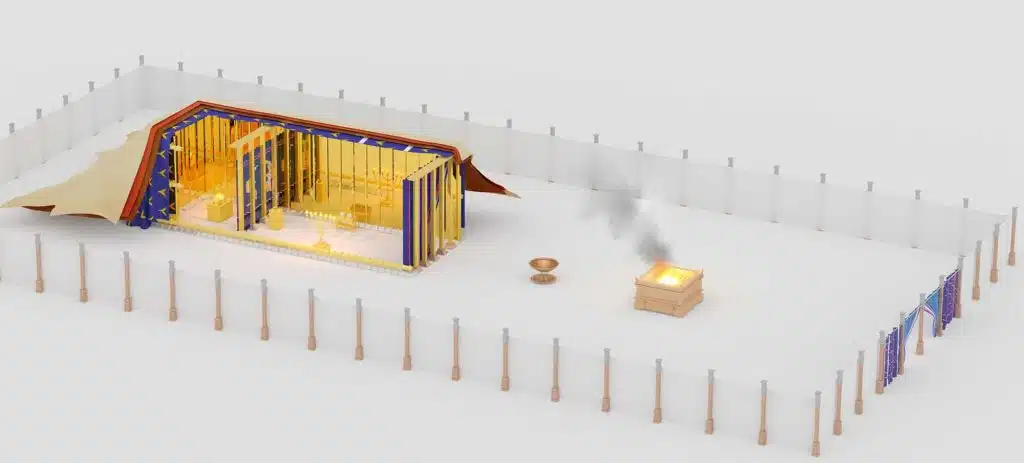
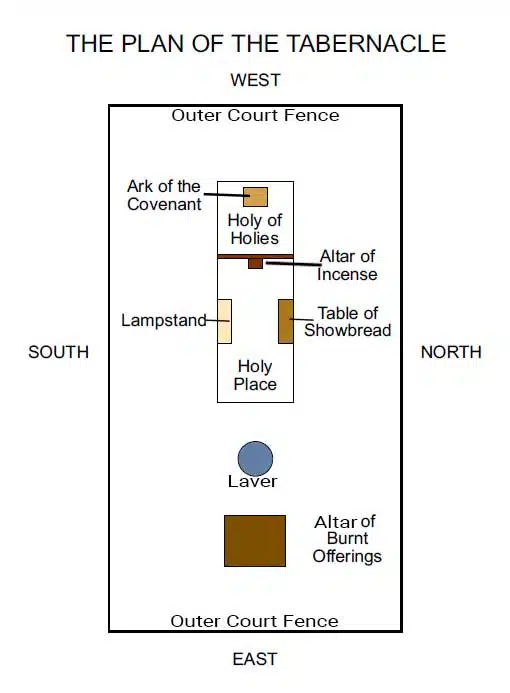
The Tabernacle seems to have fallen out of use sometime after the conquest (~1450 B.C.) until the reign of King David (~ 1020 B.C.) when he erected a Tabernacle in Jerusalem to house the Ark of the Covenant (2 Samuel 6:17).
Solomon’s Temple (957 B.C. – 587 B.C.)
While he was king, David made preparations for an actual temple building to replace the Tabernacle (1 Chronicles 22:1-5). It was patterned after the Tabernacle. But David called for his son, Solomon, to build it (1 Chronicles 22:6-7). King Solomon fulfilled his father’s wishes and built a temple on the highest mountain in Jerusalem, Mount Moriah, the place where Abraham went to sacrifice his son Isaac (2 Chronicles 3:1, Genesis 22:2). It was commemorated to house God among His people (2 Chronicles 6:1-42). Then “the glory of the Lord” came and “filled the Lord’s house” (2 Chronicles 7:2). Solomon’s temple was destroyed during the Babylonian invasion (2 Kings 25:8-9).
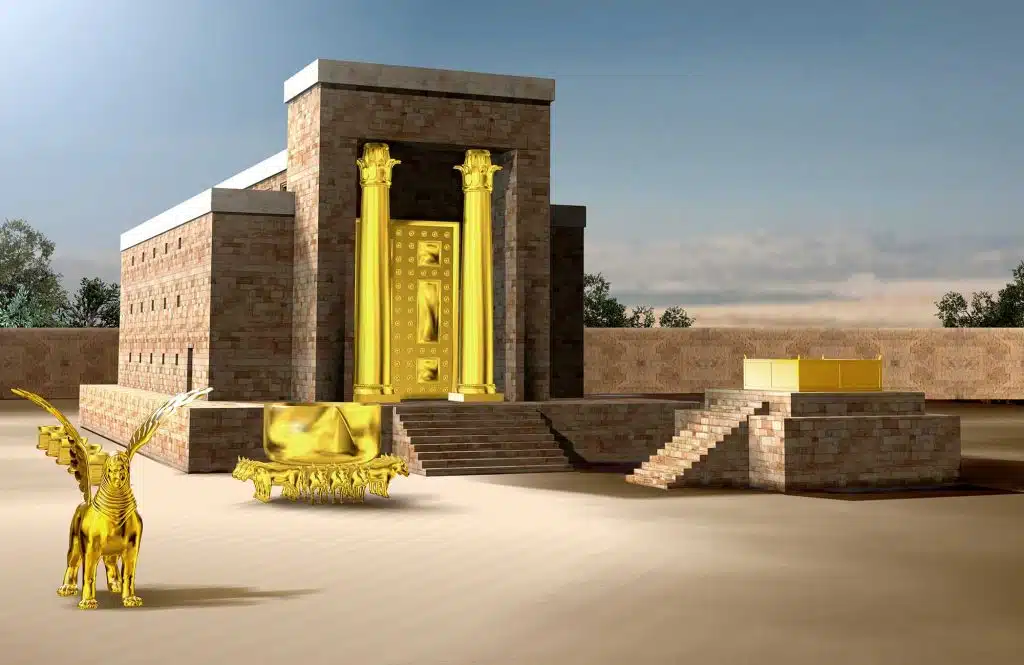
Ezekiel’s Vision of the Temple
At the conclusion of his prophecy, Ezekiel was given a cosmic, elaborate vision of a new temple. This vision is found in Ezekiel 40-47 and was given to the prophet shortly after his vision of God’s victory and judgment over His enemies. Much of his vision consists of blueprints for the temple’s gates, courtyards, inner buildings, and chambers (Ezekiel 40:5-42:20), and instructions for the new sacrificial system (Ezekiel 43:13-46:24). The temple Ezekiel saw was significantly larger than Solomon’s. In his vision, God’s glory returned from the East (Babylon) and “filled the house” (Ezekiel 43:1-5). (Recall how God’s glory filled the Tabernacle and Solomon’s temple).
The other fascinating feature of Ezekiel’s temple was a stream of water that flowed from under the threshold of the house toward the east (Ezekiel 47:1). The stream grows into a mighty river (Ezekiel 47:2-4) that fills the Dead Sea making its “waters become fresh” (Ezekiel 47:8). This transforms the sea and the surrounding lifeless valley into a new garden of Eden (Ezekiel 47:9-12).
Ezekiel’s Temple has never been literally constructed on earth.
Some believe that what Ezekiel saw was a vision of the heavenly temple that Moses saw on Mount Sinai and patterned the Tabernacle after, and that the Apostle John also saw in Revelation 15:5. What he described was its blueprint in earthly terms.
Others believe that what Ezekiel saw was a highly symbolic metaphor for the future reality of God’s Messianic kingdom restoring harmony in the new creation.
Both views are compatible.
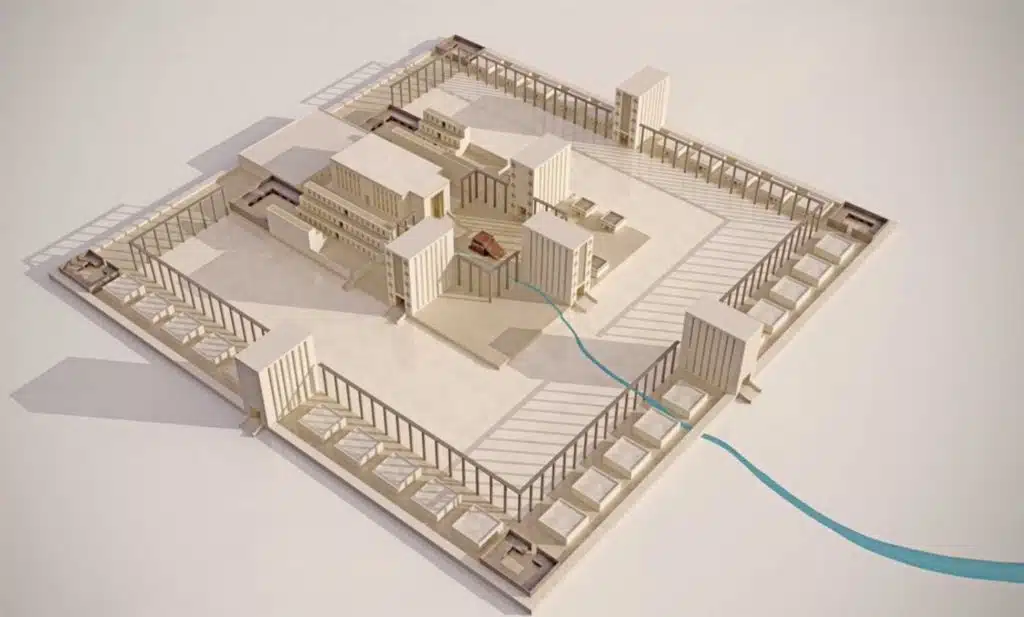
Here are three videos offering animated walkthroughs depicting a 3D Computer Graphic rendition of the temple seen by Ezekiel. They display scripture references as each feature is highlighted:
The Gates and Outer Court (Ezekiel 40:5-49)
The Inner Temple (Ezekiel 41)
The Outer Chambers and the Glory of the Lord Filling the Temple (Ezekiel 42-43:17)
Ezra’s Temple (515 B.C. – 20 B.C.)
This building is sometimes called “Zerubbabel’s Temple,” “Nehemiah’s Temple,” or simply as “the Second Temple.” It was built to replace Solomon’s Temple upon the return of Jewish exiles (Ezra 1:1-3; Ezra 3:3; Ezra 5:2-5; Ezra 6:15). Ezra’s temple was more modest than Solomon’s temple. This was the temple that the Greek tyrant Antiochus Epiphanes desecrated by erecting a statue to Zeus and sacrificing pigs as part of his universal Hellenization policy. This desecration occurred in 167 B.C. and is known as “the Abomination of Desolation,” predicted by the prophet Daniel (Daniel 11:31). This abomination led to the Maccabean Revolt which resulted in Jewish independence for a time. Judah Maccabee rededicated the temple in 164 B.C. The Roman general Pompey entered this temple when Rome took over Judea in 60 B.C.
Unlike Moses’s Tabernacle (Exodus 40:34); Solomon’s Temple (2 Chronicles 7:2); The Temple in Ezekiel’s Vision (Ezekiel 43:5); or the Temple of Believers in Jesus (Acts 11:15-17, Galatians 4:6); the Bible never explicitly states that God’s Glory filled Ezra’s Temple either before or after its renovation by Herod.
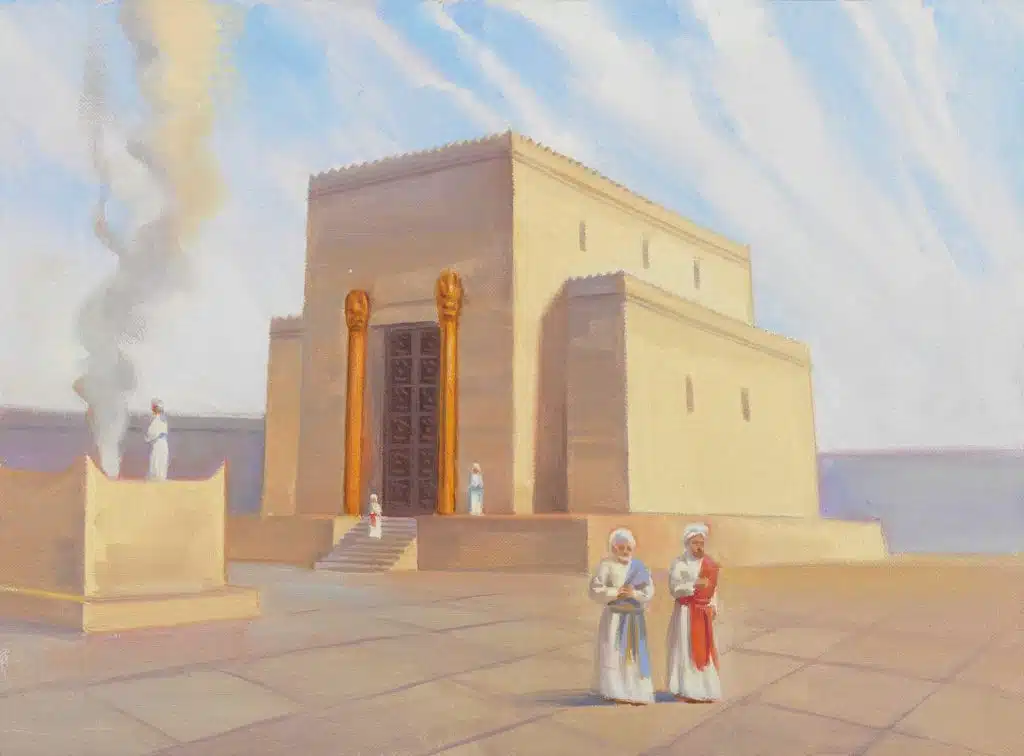
Herod’s Temple (20 B.C. – 70 A.D.)
During Herod the Great (Builder’s) reign, Ezra’s temple underwent a magnificent renovation and was greatly expanded. This ten-year project was completed in 10 or 11 B.C. This was the temple of Jesus’s day and the one used by Jews throughout the New Testament era until 70 A.D. when the temple was plundered and destroyed by the Roman General Titus during the Jewish revolt. Centuries later, Muslims built a mosque—“the Dome of the Rock”—where the Jewish temple once stood. Today only a single side remains of the massive platform upon which Herod’s temple stood. It is called the “Wailing Wall.”
Herod’s temple was a sprawling complex. It was built on top of a massive platform of stone blocks that covered a staggering thirty-five acres, or twenty percent of the walled city space of first century Jerusalem. It was surrounded by high walls, and on its north side was a Roman fortress. Its southern side had a covered porch and colonnade called “Solomon’s Portico” surrounding a massive courtyard—the court of the Gentiles.
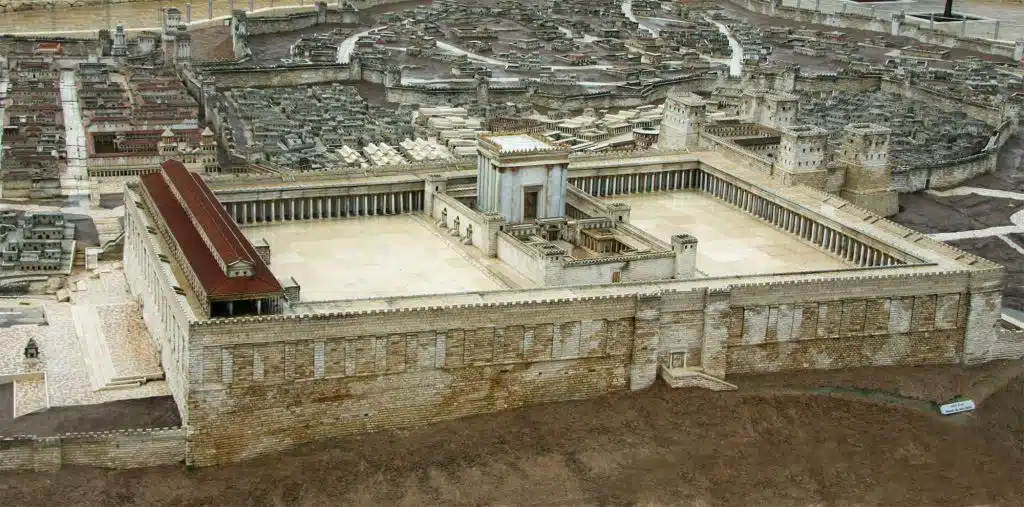
In the center of the complex was the temple proper. It was like a long, tall corridor divided by a series of courts and rooms. Only Jews were allowed to enter the temple proper.
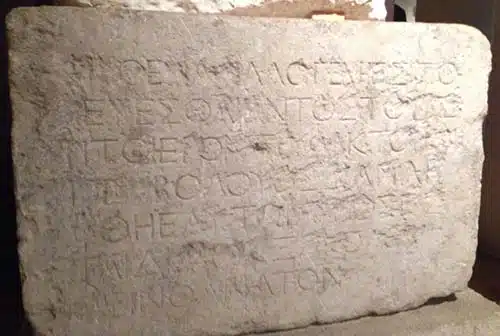
The first area of the temple proper was “The Court of Women.” This was the furthest that purified Jewish women were permitted to come. Next was “The Court of Israel” where purified male Jews were allowed. Third was “The Court of Priests.” And finally, “the House of God,” which was divided into the Holy Places and the Holy of Holies which was entered once a year by a single priest on the Day of Atonement.
It is interesting to note that unlike Moses’s Tabernacle, Solomon’s Temple, Ezekiel’s Vision, or the hearts of believers in Jesus, there is no Biblical record of Ezra’s temple or Herod’s renovation ever being filled with or inhabited by God’s Spirit. This does not mean that He did not inhabit it, only that there is no Biblical affirmation that He did.
Believers in Jesus Christ
The New Testament says that believers in Jesus Christ are the holy Temple of God and that His Spirit dwells inside of us (1 Corinthians 3:16-17). We are God’s new Temple.
“For we are the temple of the living God.”
(2 Corinthians 6:16)
Because of this marvelous reality, we are to live holy lives that honor our holy God (2 Corinthians 6:14-16).
The veil in Herod’s Temple, dividing God from man, was torn from top to bottom the instant Jesus died on the cross (Matthew 27:51.) This tearing signified the end of the old sacrificial system that required the temple. The main purpose of the old system was to foreshadow God’s New and everlasting covenant of redemption (Hebrews 10:1-3).
Now that the new system has come, the old has fulfilled its purpose and become obsolete.
“When He said, ‘A new covenant,’ He has made the first obsolete. But whatever is becoming obsolete and growing old is ready to disappear.”
(Hebrews 8:13)
“But when Christ appeared as a high priest of the good things to come, He entered through the greater and more perfect tabernacle, not made with hands, that is to say, not of this creation; and not through the blood of goats and calves, but through His own blood, He entered the holy place once for all, having obtained eternal redemption.”
(Hebrews 9:11-12)
This indwelling of the Holy Spirit into the hearts of believers first occurred on the Day of Pentecost after Jesus’s resurrection from the grave and His ascension into Heaven (Acts 2:1-4). This was a direct fulfillment of what Ezekiel prophesied.
“Moreover, I will give you a new heart and put a new spirit within you; and I will remove the heart of stone from your flesh and give you a heart of flesh. I will put My Spirit within you and cause you to walk in My statutes, and you will be careful to observe My ordinances. You will live in the land that I gave to your forefathers; so you will be My people, and I will be your God.”
(Ezekiel 36:26-28)
As believers, we now have unrestrained and constant access to God through Christ’s work and the presence of His Spirit inside of us (Ephesians 2:18). The only thing keeping us from walking with God is our choosing not to by walking in the Flesh (Galatians 5:16, 25).
The Bible also speaks of each individual believer as “living stones” in God’s temple (1 Peter 2:5) with Christ as the cornerstone (Ephesians 2:19-22).
Jesus—the firstborn from the dead (Colossians 1:18); the chief cornerstone (Matthew 21:42-44)—perhaps alluded to establishing the living temple of believers when He told the Jewish leaders “Destroy this temple and in three days I will raise it up” (John 2:19).
“The Jews then said, ‘It took forty-six years to build this temple, and will You raise it up in three days?’ But He was speaking of the temple of His body.”
(John 2:21-22)
Finally, some have observed how the blueprints and layout of the temple are arranged in such a way that they depict the body of man.
Consider how the temple layout resembles the body of a man in the rendering of the inner temple from Ezekiel’s vision.
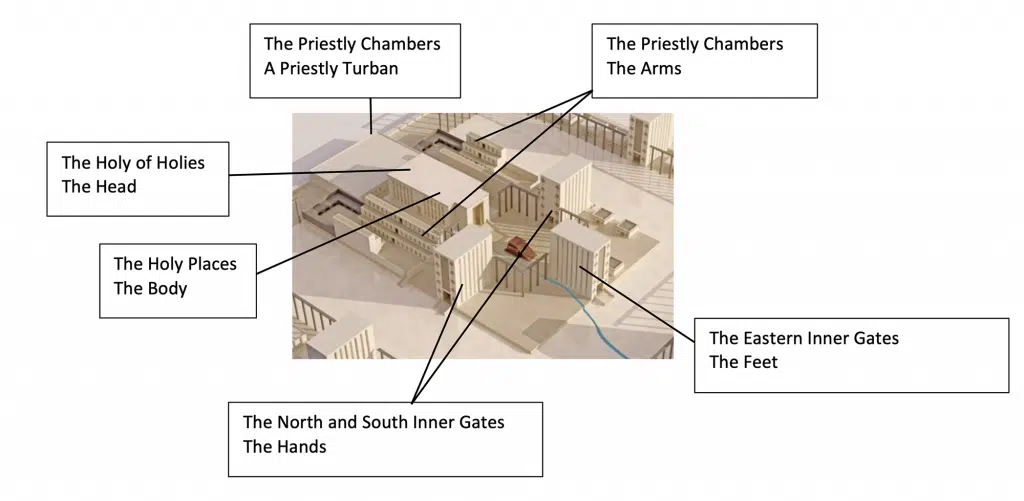
The tabernacle and temple buildings of the Old Testament foreshadow how human beings will (and now have become) the new “Beit Hamikdash.” People have become “the holy house” of God.
Check out our other commentaries:
-
Zechariah 12:10-14 meaning
All of the Jewish people, its rulers and priests and commoners, will mourn for God, whom they pierced. They will mourn so profoundly as though...... -
Amos 3:3-8 meaning
Amos uses a series of rhetorical questions to announce judgment on the disobedient Israelites....... -
Joel 1:15–20 meaning
The prophet uses the recent locust/army invasion to predict the day of the LORD, a time in which God will intervene in the world to...... -
Romans 7:9-12 meaning
The Law is perfect, but we are not. Therefore, the Law shows our imperfection and sin nature very clearly. Because the Law is perfect and...... -
Ecclesiastes 12:6-7 meaning
Life is short and our opportunity for wise stewardship (on earth) will not last forever.......


